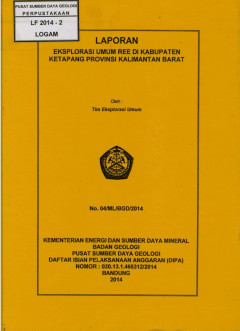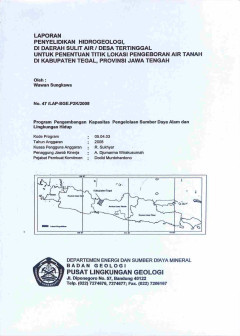Ditapis dengan

Laporan Eksplorasi Umum REE di Kabupaten Ketapang Provinsi Kalimantan Barat
Logam Tanah jarang yang juga disebut rare earth element (REE), di Indonesia keterdapatannya masih belum diketahui secara pasti, berdasarkan informasi sementara yang dapat dieksploitasi hanya dari tailing pengolahan tambang timah alluvial. Secara umum tailing pengolahan timah berupa mineral monasit. MIneral monasit merupakan salah satu mineral disamping banyak jenis mineral pembawa REE lainnya. …
- Edisi
- -
- ISBN/ISSN
- -
- Deskripsi Fisik
- viii, 86 hlm. : ilus. ; 30 c,. + Lampiran
- Judul Seri
- -
- No. Panggil
- PMB LF 2014 - 2 LG

Seismic Observation and Inter Pretation of Krakatau Complex in the Periods of…
The significant change in seismic activity for an active volcano is closely related to the stage of volcanic activity. Even in the dormancy period, the observation of seicmic activity of a particular volcano is very important to evaluate the status and to anticipate the future behavior. The Volcanological Survey of Indonesia installed triparti- te instruments at the Anak Krakatau and Sertung…
- Edisi
- -
- ISBN/ISSN
- -
- Deskripsi Fisik
- 30 hlm; tabel; gmbr; peta
- Judul Seri
- -
- No. Panggil
- PVG A.83-4

The Kelud, Volcanic Earthquakes At Lamongan Volcano In 1924.
Volcanic quakes occurred since September 20,1924. E and Ne of Ranu Klakah treasures were formed. The tromometers Klakah repetend in October 135, in September 81, in December 105 shocks.
- Edisi
- -
- ISBN/ISSN
- -
- Deskripsi Fisik
- 18 hml.; tabel
- Judul Seri
- -
- No. Panggil
- PVG E.23-1

Laporan Pengukuran dan Pemasangan Patok Qwartair di Daerah G. Rokatenda di Fl…
Sehubungan dengan belum/tidak adanya ketinggian tetap di sekitar G. Rokatenda, di daerah P. Palue, make Kepala Seksi Pengamatan Gunungapi Bali-Nusatenggara, mempunyai gagasan/pendapat agar di daerah tersebut diadakan/dipasang patok yang mempunyai ketinggian tetap. Untuk mengadakan/melaksanakan pendapat tersebut, maka penulis ditugaskan ke P. Palue selama satu bulan: ialah pada Oktober 1981. Mak…
- Edisi
- -
- ISBN/ISSN
- -
- Deskripsi Fisik
- 4 hlm.; peta
- Judul Seri
- -
- No. Panggil
- PVG G.81-9

Laporan Penyelidikan Hidrogeologi di Daerah Sulit Air / Desa Tertinggal untuk…
- Edisi
- -
- ISBN/ISSN
- -
- Deskripsi Fisik
- iii, 23 hlm.:ill;gbr;tab;lamp
- Judul Seri
- -
- No. Panggil
- PAG L2025-105
- Edisi
- -
- ISBN/ISSN
- -
- Deskripsi Fisik
- iii, 23 hlm.:ill;gbr;tab;lamp
- Judul Seri
- -
- No. Panggil
- PAG L2025-105

Earth Moves
Earth moves, Bernard Chache’s first major work, conceptualizes a series of architectural images as vehicles for two important developments. First, he offers a new under standing of the architectural image itself.
- Edisi
- -
- ISBN/ISSN
- -
- Deskripsi Fisik
- 155 hal.; gbr.;
- Judul Seri
- -
- No. Panggil
- -

Volcanoes & Earthquakes: Geo Detectives
- Edisi
- -
- ISBN/ISSN
- 978 0 7112 4461 0
- Deskripsi Fisik
- 32 hlm.
- Judul Seri
- -
- No. Panggil
- PSG 55.21+550.4 GAN v
- Edisi
- -
- ISBN/ISSN
- 978 0 7112 4461 0
- Deskripsi Fisik
- 32 hlm.
- Judul Seri
- -
- No. Panggil
- PSG 55.21+550.4 GAN v

Indonesian Heritage Amazing Stories of Provinces Jakarta: My First Cartoonal …
- Edisi
- -
- ISBN/ISSN
- 978-979-3973-75-3
- Deskripsi Fisik
- 39 hlm.
- Judul Seri
- -
- No. Panggil
- PSG 347.66(910)(03) SUN i
- Edisi
- -
- ISBN/ISSN
- 978-979-3973-75-3
- Deskripsi Fisik
- 39 hlm.
- Judul Seri
- -
- No. Panggil
- PSG 347.66(910)(03) SUN i

1001 Ways to Save the Earth
- Edisi
- -
- ISBN/ISSN
- 978-0-8118-5986-8
- Deskripsi Fisik
- 384 hlm.
- Judul Seri
- -
- No. Panggil
- PSG 55 YAR s
- Edisi
- -
- ISBN/ISSN
- 978-0-8118-5986-8
- Deskripsi Fisik
- 384 hlm.
- Judul Seri
- -
- No. Panggil
- PSG 55 YAR s

Active Earth
- Edisi
- -
- ISBN/ISSN
- 978-1-78209-636-8
- Deskripsi Fisik
- 40 hlm.
- Judul Seri
- -
- No. Panggil
- PSG 55 BED a
- Edisi
- -
- ISBN/ISSN
- 978-1-78209-636-8
- Deskripsi Fisik
- 40 hlm.
- Judul Seri
- -
- No. Panggil
- PSG 55 BED a
 Karya Umum
Karya Umum  Filsafat
Filsafat  Agama
Agama  Ilmu-ilmu Sosial
Ilmu-ilmu Sosial  Bahasa
Bahasa  Ilmu-ilmu Murni
Ilmu-ilmu Murni  Ilmu-ilmu Terapan
Ilmu-ilmu Terapan  Kesenian, Hiburan, dan Olahraga
Kesenian, Hiburan, dan Olahraga  Kesusastraan
Kesusastraan  Geografi dan Sejarah
Geografi dan Sejarah